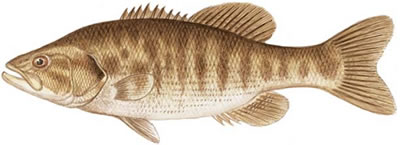Fish Identification
Plenty of fish identification
Florida Largemouth Bass (Micropterus salmoides floridanus)
The Florida largemouth bass, also known as the Florida bass, is a subspecies of the largemouth bass, which in turn is often called a northern largemouth. This fish occurs naturally in Florida. Mixtures of it and northern largemouth are called intergrades, as they are neither pure Florida nor pure northern strains. These fish occur from northern Florida to Maryland.
Florida bass grow to trophy size more readily than do northern largemouth bass. They have been stocked in many states, including California, which has produced near–world record 22-pounders from transplanted stocks, and in Texas, which has completely transformed its big-bass potential by stocking this fish.
loading...
Guadalupe Bass (Micropterus punctulatus)
The Guadalupe bass is a member of the Centrarchidae family and is similar to the spotted bass (see: Bass, Spotted) in appearance. It has 10 to 12 dark bars along its sides, which are less distinct in older fish; it usually has 16 pectoral rays and 26 to 27 scales around the caudal peduncle. It can grow to almost 16 inches and usually weighs less than a pound. The all-tackle world record is a 3-pound, 11-ounce Texas fish taken in 1983.
In North America, Guadalupe bass are restricted to the Edwards Plateau in the Brazos, Colorado, Guadalupe, San Antonio, and upper Nueces (where introduced) River drainages in southern Texas. They occur in gravel riffles, runs, and flowing pools of creeks, as well as in small to medium rivers.
loading...
Largemouth Bass (Micropterus salmoides)
The largemouth bass is the biggest and most renowned member of the Centrarchidae family of sunfish and its subgroup known as black bass. It is sometimes confused with the smallmouth in places where both species occur, and also with the spotted bass (see: Bass, Spotted). One subspecies, the Florida largemouth bass (see: Bass, Florida Largemouth), M. salmoides floridanus, is capable of attaining large sizes in appropriate waters but is otherwise similar.
Identification
The largemouth bass has an elongated and robust shape compared to other members of the sunfish family. It has a distinctively large mouth, as the end of its maxillary (jaw) falls below or beyond the rear margin of the eye; the dorsal fin has a deep notch separating the spiny and soft rays; and the tail is broad and slightly forked.loading...
Peacock Bass
Peacock bass are among the world’s hardest-fighting freshwater fish. They willingly take lures, strike hard, and provide a strong and exciting battle.
The term “peacock bass” is a misnomer, but it is a name that has good marketing value and one that has stuck in the English-speaking world. Species that are called peacock bass in English are formally known as pavón in Spanish-speaking countries and as tucunaré in Brazil.
loading...
Redeye Bass (Micropterus coosae)
 |
| Redeye Bass (Micropterus coosae) |
There are two widely recognized forms of this member of the black bass group of the Centrarchidae family: the Apalachicola, which is called a shoal bass, and the Alabama, which is generally referred to as the redeye bass or the true redeye.
The shoal bass has yet to be described fully or given a distinct scientific name, and there is some confusion over the two. A scrappy fighter, the redeye bass often jumps when hooked and is hard to catch. Its white, flaky meat is of good table quality, similar to that of other black bass.
loading...
Roanoke Bass (Ambloplites cavifrons)
 |
| Roanoke Bass (Ambloplites cavifrons) |
The Roanoke bass is a sunfish and a member of the Centrarchidae family, similar in body shape to a rock bass (see: Bass, Rock) or warmouth (see). It can be identified by its unscaled or partly scaled cheek and the several iridescent gold to white spots on its upper side and head. It is olive to tan above, has a dark and light marbling on the sides, and often sports rows of black spots and a white to bronze breast and belly.
It is also distinguished by the 39 to 49 lateral scales, 11 anal rays, and 27 to 35 scale rows across its breast between the pectoral fins. The all-tackle world record is a 1-pound, 5-ounce fish taken in Virginia in 1991. Growing to a maximum of 14.5 inches, the Roanoke
loading...
Rock Bass (Ambloplites rupestris)
 |
| Rock Bass (Ambloplites rupestris) |
The rock bass is actually a member of the sunfish family and is not a true bass. Rock bass are fun to catch because they can be caught on many types of baits and lures, and they put up a decent fight on ultralight tackle. Rock bass are known to overpopulate small lakes, making population control measures necessary.
Identification
Although it looks like a cross between a bluegill and a black bass, the rock bass is actually a large and robust sunfish with a deep body; it is less compressed than most sunfish and is more similar to a black bass in shape. The back is raised, and the large head is narrow, rounded, and deep.loading...
Subscribe to:
Posts (Atom)



